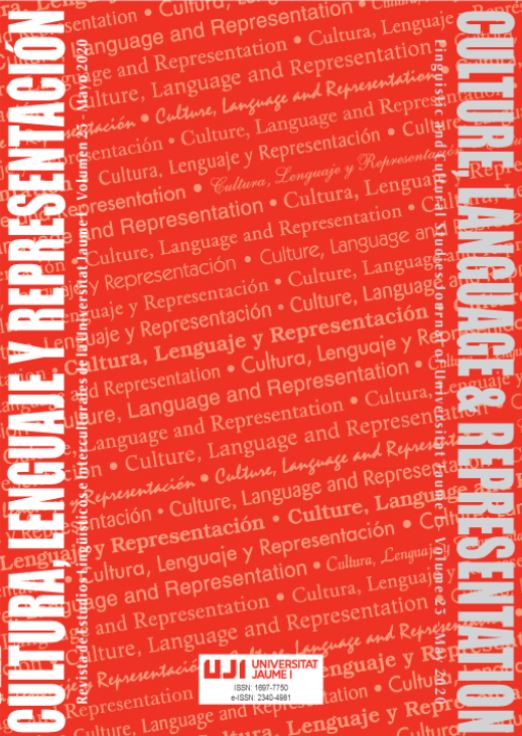La epopeya dañada: patología familiar en As I Lay Dying
Contenido principal del artículo
Resumen
El objetivo de este artículo es dilucidar mediante qué estrategias narrativas se construyen las relaciones familiares patológicas de una de las novelas más notables de William Faulkner, la cual resulta ser una expresión literaria representativa de la complejidad que adquieren las relaciones afectivas a partir de la modernidad, asunto que no ha perdido vigencia. Combinando una lectura narratológica y una lectura psicológica, el análisis aquí propuesto examina las motivaciones, problemáticas y contradicciones de los personajes de As I Lay Dying en relación al particular contexto histórico en el que están insertos, tan típico en Faulkner, marcado por la carencia, la represión y la imposición de roles sociales estrictos, algo que marca fuertemente su subjetividad. En última instancia, el artículo se cuestiona también en qué medida la disfuncionalidad emocional de la que estos hacen gala tiene un origen social que radica en la institución misma de la familia como estructura básica de socialización.
Descargas
Detalles del artículo
Se utiliza una licencia de derechos de autor CREATIVE COMMONS de acceso abierto.
Aquellos autores/as cuyos trabajos sean publicados por esta revista esta revista, aceptan los términos siguientes:
Concretamente mediante las siguientes acciones:
- - Los autores/as conservarán sus derechos de autor y garantizarán a la revista el derecho de primera publicación de su obra, el cuál estará simultáneamente sujeto a la Licencia de reconocimiento de Creative Commons CC BY SA que permite a terceros compartir la obra siempre que se indique su autor y su primera publicación esta revista.
- - Cumplimiento de un porcentaje mínimo del 40% de mujeres como revisoras de los trabajos enviados a la revista.
- - Los autores/as conservarán sus derechos de autor y garantizarán a la revista el derecho de primera publicación de su obra, el cuál estará simultáneamente sujeto a la Licencia de reconocimiento de Creative Commons CC BY SA que permite a terceros compartir la obra siempre que se indique su autor y su primera publicación esta revista.
- - Los autores/as podrán adoptar otros acuerdos de licencia no exclusiva de distribución de la versión de la obra publicada (p. ej.: depositarla en un archivo telemático institucional o publicarla en un volumen monográfico) siempre que se indique la publicación inicial en esta revista.
- - Se permite y recomienda a los autores/as difundir su obra a través de Internet (p. ej.: en archivos telemáticos institucionales o en su página web) antes y durante el proceso de envío, lo cual puede producir intercambios interesantes y aumentar las citas de la obra publicada.
Citas
Adorno, Theodor W. 1987. Minima moralia. Reflexiones desde la vida dañada. Madrid: Taurus.
Atkinson, Ted. 2006. Faulkner and the Great Depression: Aesthetics, Ideology, and Cultural Politics. Athens: University of Georgia Press.
Azevedo, Carlos. 2014. Do Modernismo em William Faulkner: As I Lay Dying. Estudos em homenagem a Margarida Llosa, 2006, 71-97.
Benveniste, Émile. 1999. “El aparato formal de la enunciación”, en Problemas de lingüística general, II (pp. 82-91). Madrid: Siglo XXI.
Bergman, Jill. 1996. ‘this was the answer to it’: Sexuality and Maternity in As I Lay Dying. Mississippi Quarterly, 49(3), 393–407.
Bollinger, Laurel. 2015. “Are is too many for one woman to foal”: Embodied Cognition in As I Lay Dying. Texas Studies in Literature and Language, 57(4), 433-463.
Butchart, Liam C. 2015. Death, Mourning and Human Selfishness: Faulkner's As I Lay Dying Through a Freudian Lens. PSYART: A Hyperlink Journal for the Psychological Study of the Arts. Available at http://psyartjournal.com/article/show/butchart-death_mourning_and_human_selfishness_fau. August 9, 2019.
Catchings, Libby. 2014. Elegy, Effigy: Alchemy and the Displacement of Lament in As I Lay Dying. The Faulkner Journal, 28(2), 25-38.
Clancier, Anne. 1973. Pschanalyse et critique littéraire. París: Privat.
Clarke, Deborah. 1994. Robbing the Mother. Women in Faulkner. Jackson: University Press of Mississippi.
Eagleton, Terry. 2011. Dulce violencia. La idea de lo trágico. Madrid: Trotta.
Faulkner, William. 1985. As I Lay Dying. Nueva York: Vintage International.
Foucault, Michel. 1992. El orden del discurso. Buenos Aires: Tusquets.
Fowler, Doreen. 1989. Matricide and Mother’s Revenge: As I Lay Dying. The Faulkner Journal, 4(1), 113-125.
Hannon, Charles. 2015. The Function of Function Words in William Faulkner’s As I Lay Dying. The Faulkner Journal, 29(1), 3-21.
Hewson, Marc. 2000. ‘My children were of me alone’: Maternal Influence in Faulkner’s As I Lay Dying. Mississippi Quarterly, 53(4), 551–67.
Irigaray, Luce. 1981. Le Corps-à-corps avec la mère. París: Pleine Lune.
Kovesdy, Joe. 2010. Dewey Dell in Faulkner’s AS I LAY DYING. The Explicator, 68(4), 261-263.
Lacan, Jacques. 1978. La familia. Barcelona: Editorial Argonauta.
Mauron, Charles. 1963. Des métaphores obsédantes au mythe personnel. París: Corti.
Palliser, Charles. 1986. Predestination and Freedom in As I Lay Dying. American Literature, 58 (4), 577-573.
Ross, Stephen M. 1979. “Voice” in Narrative Texts: The Example of As I Lay Dying. PMLA, 94 (2), 300-310.
Roudinesco, Elisabeth. 2004. La familia en desorden. Barcelona: Anagrama.
Sartre, Jean-Paul. 1947. “À propos de « Le bruit et la fureur »: La temporalité chez Faulkner” en Situations, I (pp. 65-75). París: Gallimard.
Southard, Marybeth. 2013. “Aint None Of Us Pure Crazy”: Queering Madness in As I Lay Dying. The Faulkner Journal, 27(1), 47-63.


